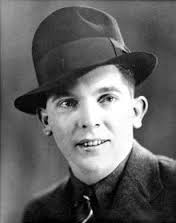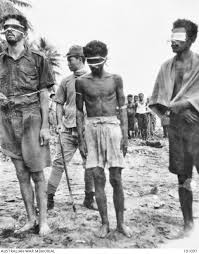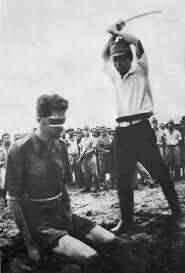Sgt. Leonard George “Len” Siffleet

Sgt. Leonard George “Len ” Siffleet was an Australian commando on a mission in Papua New Guinea who was captured by the Japanese. He was Interrogated, tortured and beheaded by the Japanese along with his two Ambonese companions. A photograph of Siffleet’s impending execution became an enduring image of the war.
He was Born in Gunnedah, New South Wales on January 14 1916. Born to a family with modest income, and with three other siblings, his father would often look for work away from home to sustain their needs. He grew up taking care of his younger brothers with the help of his sister, Pearl. A keen sportsman, he became a good swimmer but also enjoyed less physical pursuits; he once outfitted the Gunnedah pipe band with highland hose that he had knitted.
In the late 1930’s, Siffleet tried joining the police force but was not accepted due to his eyesight not meeting to the Police force’s standards. Whatever defect that marred his vision, it was not sufficiently serious to prevent his being called up for the militia in August 1940. He served with a searchlight unit at Richmond Air Force Base but was released after three months and returned to civilian life.
After his mother’s death in 1941, he and his sister, Pearl, took responsibility for bringing up their two youngest brothers, a task made necessary by the itinerant nature of their father’s work. In July 1941, he enlisted into the Australian Army, and was assigned to the 1st Division Signal Section at Ingleburn. In September 1941, Siffleet joined the AIF and was posted to the 1st Division Signals Company at Ingleburn. He twice went absent without leave, possibly to see the woman to whom he had become engaged, Clarice Lane.
After training in radio communications at Melbourne Technical College, Siffleet volunteered for special operations in September 1942 and was posted to the Services Recon Dept. (SRD) of the Allied Intelligence Bureau in Melbourne. He joined Z Special Unit in October and was transferred to Cairns, Queensland for further operational training. Assigned to the SRD’s Dutch section as a radio operator,
Siffleet was promoted Sergeant in May 1943. He moved across to M Special Unit that same month to take part in a mission to set up a Coast Watching Station in the hills behind Hollandia in Papua New Guinea. Commander Eric Feldt, director of the Coast watchers described him as “the best type of N.C.O. of the A.I.F., young and competent”, Siffleet joined a party led by Sergeant H. N. Staverman of the Royal Netherlands Navy, and two Ambonese privates named H. Pattiwal and M. Reharing. Code-named “Whiting”, this team was to work in concert with another group known as “Locust”, led by Lieutenant Jack Fryer.
Staverman’s reconnaissance group commenced its mission in north-east New Guinea in July, trekking across mountainous terrain through August and September. At some point Staverman and Pattiwal separated from the others to undertake further exploration of the countryside, and were ambushed by a group of natives friendly to the Japanese . Both were captured and reported as killed, but Pattiwal later escaped and rejoined Siffleet and Reharing.
Siffleet signalled Fryer to warn him of the hostile natives and of Japanese patrols, indicating that he was preparing to burn his party’s codes and bury its radio. No more was heard from them after early October. Clarice Lane, Siffleet’s fiancee (incorrectly addressed as “Clemice” Lane) had in the meantime received two letters from the Allied Intelligence Bureau in July and September, stating that Siffleet was “safe and well”

After Pattiwal rejoined Siffleet and Reharing, they attempted to make their way to the Dutch border. They were ambushed by a hundred native villagers near Aitape and, after a brief melée during which Siffleet shot and wounded one of their attackers, the group was captured and handed over to the Japanese. Interrogated and tortured, the team was confined for approximately two weeks before being taken down to Aitape Beach on the afternoon of 24 October 1943.
Bound and blindfolded, surrounded by Japanese and native onlookers, they were forced to the ground and executed by decapitation, on the orders of Vice-Admiral Michiaki Kamada IJN. Siffleet’s body and those of his two comrades were destroyed by the Japanese. The officer who executed Siffleet, Yasuno Chikao, detailed a private to photograph him in the act. At the end of the war, Chikao was captured, tried for war crimes and sentenced to be hanged; his sentence was commuted to ten years imprisonment, and upon completion of his sentence, he returned to Japan.
The photograph of Siffleet’s execution was discovered on the body of a dead Japanese major near Hollandia by American troops in April 1944. It is believed to be the only surviving depiction of a western POW being executed by a Japanese soldier. The picture was published in Australian newspapers and in Life magazine but was thought to depict Flight Lieutenant Bill Newton VC, who had been captured in Salamaua, Papua New Guinea, and beheaded on 29 March 1943. It later went on display at the Australian War Memorial. However, despite positive identification in 1945 of Siffleet as the soldier pictured, the image continues on occasion to be misidentified as Newton. Siffleet is commemorated on the Lae Memorial in Lae, Papua New Guinea, together with all other commonwealth war dead from actions in the region who have no known grave. In Australia, He is honored at the Australian War Memorial in Campbell, Canberra, Australia.





